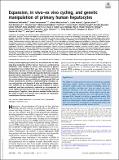| dc.contributor.author | Michailidis, Eleftherios | |
| dc.contributor.author | Vercauteren, Koen | |
| dc.contributor.author | Mancio-Silva, Liliana | |
| dc.contributor.author | Andrus, Linda | |
| dc.contributor.author | Jahan, Cyprien | |
| dc.contributor.author | Ricardo-Lax, Inna | |
| dc.contributor.author | Zou, Chenhui | |
| dc.contributor.author | Kabbani, Mohammad | |
| dc.contributor.author | Park, Paul | |
| dc.contributor.author | Quirk, Corrine | |
| dc.contributor.author | Pyrgaki, Christina | |
| dc.contributor.author | Razooky, Brandon | |
| dc.contributor.author | Verhoye, Lieven | |
| dc.contributor.author | Zoluthkin, Irene | |
| dc.contributor.author | Lu, Wei-Yu | |
| dc.contributor.author | Forbes, Stuart J | |
| dc.contributor.author | Chiriboga, Luis | |
| dc.contributor.author | Theise, Neil D | |
| dc.contributor.author | Herzog, Roland W | |
| dc.contributor.author | Suemizu, Hiroshi | |
| dc.contributor.author | Schneider, William M | |
| dc.contributor.author | Shlomai, Amir | |
| dc.contributor.author | Meuleman, Philip | |
| dc.contributor.author | Bhatia, Sangeeta N | |
| dc.contributor.author | Rice, Charles M | |
| dc.contributor.author | de Jong, Ype P | |
| dc.date.accessioned | 2021-10-27T20:34:36Z | |
| dc.date.available | 2021-10-27T20:34:36Z | |
| dc.date.issued | 2020 | |
| dc.identifier.uri | https://hdl.handle.net/1721.1/136265 | |
| dc.description.abstract | © 2020 National Academy of Sciences. All rights reserved. Primary human hepatocytes (PHHs) are an essential tool for modeling drug metabolism and liver disease. However, variable plating efficiencies, short lifespan in culture, and resistance to genetic manipulation have limited their use. Here, we show that the pyrrolizidine alkaloid retrorsine improves PHH repopulation of chimeric mice on average 10-fold and rescues the ability of even poorly plateable donor hepatocytes to provide cells for subsequent ex vivo cultures. These mouse-passaged (mp) PHH cultures overcome the marked donor-to-donor variability of cryopreserved PHH and remain functional for months as demonstrated by metabolic assays and infection with hepatitis B virus and Plasmodium falciparum. mpPHH can be efficiently genetically modified in culture, mobilized, and then recultured as spheroids or retransplanted to create highly humanized mice that carry a genetically altered hepatocyte graft. Together, these advances provide flexible tools for the study of human liver disease and evaluation of hepatocytetargeted gene therapy approaches. | |
| dc.language.iso | en | |
| dc.publisher | Proceedings of the National Academy of Sciences | |
| dc.relation.isversionof | 10.1073/PNAS.1919035117 | |
| dc.rights | Article is made available in accordance with the publisher's policy and may be subject to US copyright law. Please refer to the publisher's site for terms of use. | |
| dc.source | PNAS | |
| dc.title | Expansion, in vivo–ex vivo cycling, and genetic manipulation of primary human hepatocytes | |
| dc.type | Article | |
| dc.contributor.department | Massachusetts Institute of Technology. Institute for Medical Engineering & Science | |
| dc.contributor.department | Howard Hughes Medical Institute | |
| dc.contributor.department | Koch Institute for Integrative Cancer Research at MIT | |
| dc.contributor.department | Massachusetts Institute of Technology. Department of Electrical Engineering and Computer Science | |
| dc.relation.journal | Proceedings of the National Academy of Sciences of the United States of America | |
| dc.eprint.version | Final published version | |
| dc.type.uri | http://purl.org/eprint/type/JournalArticle | |
| eprint.status | http://purl.org/eprint/status/PeerReviewed | |
| dc.date.updated | 2020-12-02T18:31:30Z | |
| dspace.orderedauthors | Michailidis, E; Vercauteren, K; Mancio-Silva, L; Andrus, L; Jahan, C; Ricardo-Lax, I; Zou, C; Kabbani, M; Park, P; Quirk, C; Pyrgaki, C; Razooky, B; Verhoye, L; Zoluthkin, I; Lu, W-Y; Forbes, SJ; Chiriboga, L; Theise, ND; Herzog, RW; Suemizu, H; Schneider, WM; Shlomai, A; Meuleman, P; Bhatia, SN; Rice, CM; de Jong, YP | |
| dspace.date.submission | 2020-12-02T18:31:41Z | |
| mit.journal.volume | 117 | |
| mit.journal.issue | 3 | |
| mit.license | PUBLISHER_POLICY | |
| mit.metadata.status | Authority Work and Publication Information Needed | |
